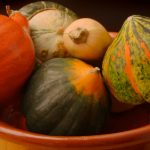Winter Squashes: From Dips to Desserts

 Pumpkins are chock full of the FoodTrient carotenoids, which our bodies turn into vitamin A. These nutrients are really good for your skin, hair, eyes, and heart. They also help prevent cancer and support the immune system. Winter squash is also a good source of the FoodTrient fiber, which helps to control the appetite and is good for the digestive tract. So I’m exploring delicious ways to enjoy many interesting fall fruits of the vine: pumpkins, kabocha squash, butternut squash, acorn squash, hubbard squash, and turban squash.
Pumpkins are chock full of the FoodTrient carotenoids, which our bodies turn into vitamin A. These nutrients are really good for your skin, hair, eyes, and heart. They also help prevent cancer and support the immune system. Winter squash is also a good source of the FoodTrient fiber, which helps to control the appetite and is good for the digestive tract. So I’m exploring delicious ways to enjoy many interesting fall fruits of the vine: pumpkins, kabocha squash, butternut squash, acorn squash, hubbard squash, and turban squash.
At this time of the year, pumpkin pie is very popular. Since I don’t love pumpkin, I make a pie with a combination of fruit, such as apple, and pumpkin. Here are several ways to incorporate pumpkins and other squashes into your diet:
SNACKS
- For a mid-morning snack, I slice pumpkin spice bread, toast the slices, and spread them with apple butter or cream cheese.
- You can buy squash chips at a nearby Thai market or make them at home: peel, de-seed, and slice raw Hubbard squash on a mandolin or other food slicer and lay the chips on a greased baking sheet in a single layer. Then set your oven to its lowest setting (200 degrees or so), and let the chips dry out in the oven overnight. A light sprinkling of sea salt will really bring out their flavor. Serve them with my Moringa Dip, an olive oil mayonnaise–based dip you’ll find in my cookbook FoodTrients: Age-Defying Recipes for a Sustainable Life.
LUNCH
- For lunch, you can enjoy another moringa-squash recipe: Moringa Vegetable Soup. The bright green, grassy moringa leaves lend a snappiness to the earthy, mild flavor of kabocha squash. You can also find this soup with a chicken-stock base and veggies like okra and eggplant in my cookbook. In addition to carotenoids and fiber, it contains a host of other powerful FoodTrients, including anthocyanins, lycopene, oleocantha, potassium, quercetin, sulfur compounds, and vitamin C.
- If you prefer to make a pure squash soup, steam or boil butternut squash (without the rind or seeds) and blend with salt, a bit of balsamic vinegar or soy sauce, and some chicken or vegetable stock (to thin it out). A spoonful or two of yogurt smoothes the tastes of this soup nicely. Top with croutons or toasted pumpkin seeds. For a spicier dish, stir in a sprinkling of cayenne pepper and/or paprika.
DINNER
- For dinner, stir-fry one-inch cubes of acorn squash, chopped kale, olive oil, garlic, onions, and freshly grated ginger—you can add string beans and scallions, too—in peanut oil for 7–10 minutes, or until crisp-tender. To make the sauce, mix oyster sauce and cornstarch and add it to the stir-fry near the end of cooking. This dish is wonderful topped with seared beef or fried tofu and served over brown rice.
DESSERT
- For a carotenoid-rich dessert, use cubes of pumpkin or almost any winter squash without its seeds or rind. I boil the cubes in a mixture of equal parts sugar and water (a simple syrup, really) until tender, 10–15 minutes. Then I serve it with butter and maybe a sprinkling of cinnamon.
There are plenty of opportunities to enjoy the fruits of the fall, even for a non-pumpkin lover like me!